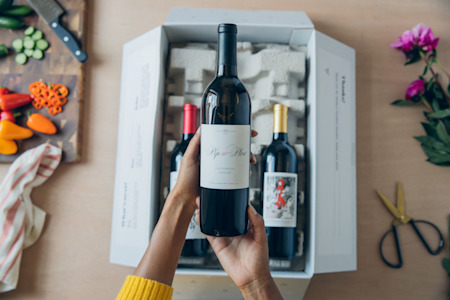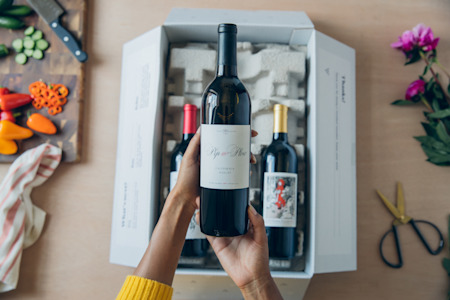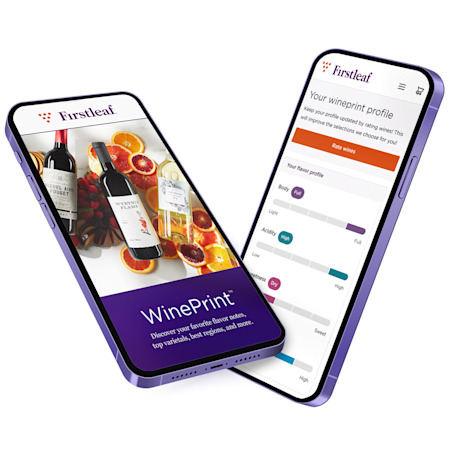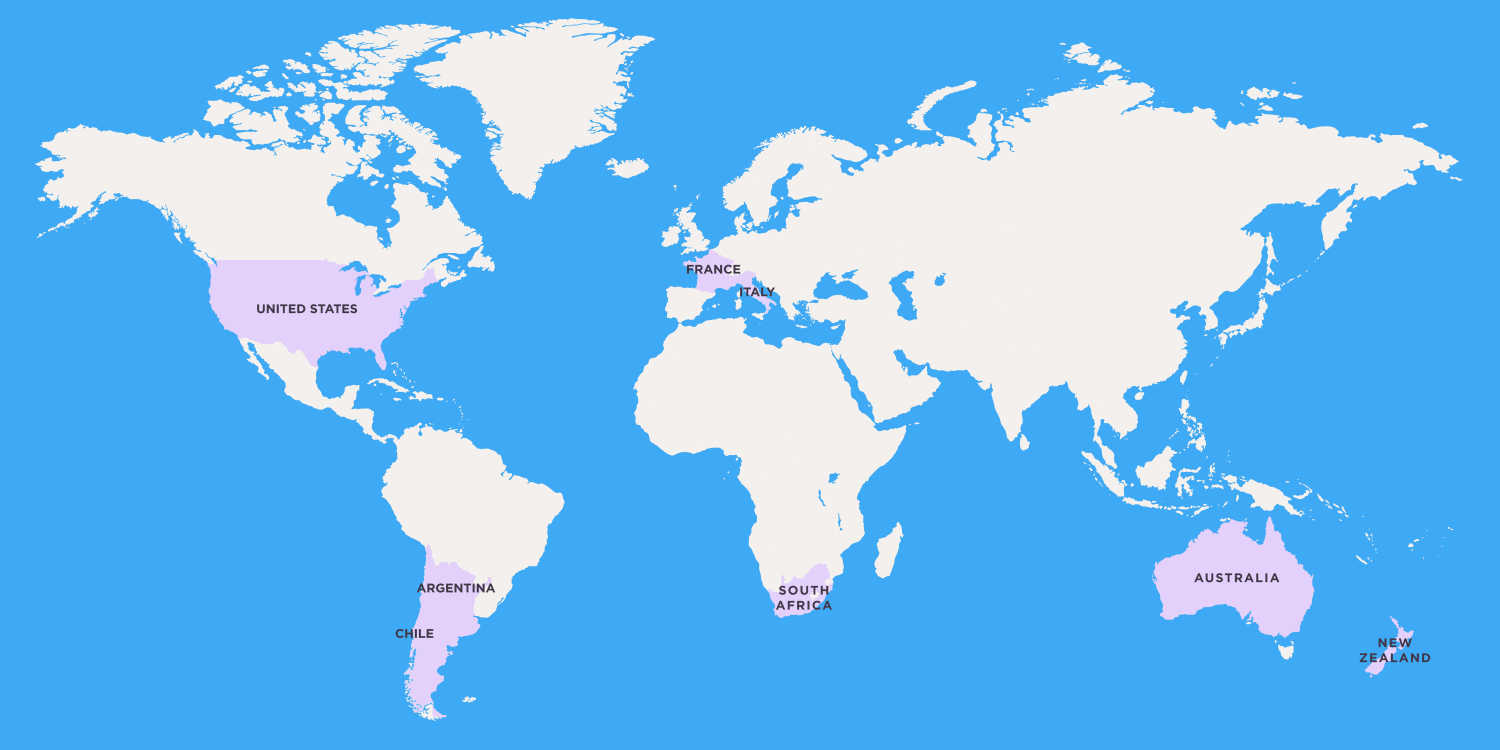Chardonnay
Chardonnay is a white wine grape that can be all things to all white wine drinkers
Chardonnay is a white wine grape that can be all things to all white wine drinkers. Hailed for its versatility by some and reviled as an interloper by others, Chardonnay is truly an international grape that can produce incredibly unique and distinct wines in all different climates and soils. It can be a transparent showcase of terroir as easily as it can be a pièce de résistance for a talented winemaker wanting to showoff.
Chardonnay can produce dry wines as easily as it produces sweet wines. It can make still wine and it can make sparkling wine. It can taste of fresh green apples and minerals in one iteration and toasty vanilla and caramel in another. It can be lean and full of acidity as easily as it can be buttery and creamy.
The hand of the winemaker from Chablis and Champagne to Burgundy and out to Napa Valley and Australia is easily seen in the neutral Chardonnay grape. Its swift rise in popularity in the 1970s and 80s led to a backlash (A.B.C. "Anything But Chardonnay") in the 1990s and 2000s. Thankfully this sentiment has mellowed into a new era of diversity in style, with great examples being made all over the world. The best-made Chardonnays can be cellared for quite some time.
Typical notes range from green apple, citrus, and flint to tropical fruit, flowers, fig, hazelnut, vanilla, butterscotch, honey, or oak. This versatility and ease of cultivation has led to the demise of many indigenous grape varieties around the world that are more difficult to cultivate. This is why Chardonnay, like Cabernet Sauvignon, is sometimes called a "colonizer."

Take Our Quiz Today
Get award-winning delicious wines from all over the world shipped straight to your door. Take the quiz to get the perfect pairings for your holiday season.
Take The Quiz TodayIN THIS ARTICLE:
History of Chardonnay
For many years Chardonnay (pronounced shar-doh-nay) was confused with Pinot Blanc as they look similar in the vineyard. There have been many theories about the origin of Chardonnay: maybe the grape originated from Muscat, maybe it was from Cyprus in the Mediterranean, or maybe that it came from Middle Eastern vineyards and was brought back by Crusaders returning from the Holy Land. Recent genetic testing, however, has shown that the grape came from a cross between Pinot Noir and Gouais Blanc. While it is much less romantic it still shares some whimsy as Gouais Blanc was brought across the Alps by the Romans and grown all across eastern France.
The first official mention of Chardonnay comes from the 1600s in Mâconnais, but it is believed to have been planted around Burgundy and along the Côte de Beaune up to Chablis even earlier. It is noted to have arrived in Champagne around the end of the 18th century and was a late addition to the sparkling Champagne wines.
Fun Fact
Due to Apartheid restrictions, much of the Chardonnay that is now enjoyed in South Africa comes from vines that were smuggled into the country in the 1970s.
Around the same time period, the grape found its way to Italy, where it has thrived. Adopted as Gelber Weissburgunder or "Golden White Burgundy" in Alto Adige (Sudtirol), it slowly moved across the northern Italian vineyards and was used in Franciacorta, another sparkling wine made in a similar style to Champagne. Today it can be found all across the Italian peninsula.
Like other international grapes, Chardonnay made its way to colonies in the New World. Over the years and especially in the second half of the 20th century Chardonnay from California and Australia began to hit its stride.
In the infamous "Judgement of Paris" of 1976 the Chateau Montelena Chardonnay beat out wines from Domaine Roulot, Joseph Drouhin, and Domaine Leflaive shocking the French judges and changing the perception of New World winemaking. Across the young winemaking regions, winemakers began focusing on producing their own styles of Chardonnay.
This led to the production of a more "international" style of Chardonnay that was heavily oaked, buttery, and exhibited tropical fruit flavors.
Today winemakers all over the world grow the grape which can be used as a canvas to showcase either terroir or winemaking skill.
What does Chardonnay taste like?
Chardonnay grapes are truly international and come in many different styles. The main styles would be Old World (White Burgundy and Chablis, although these taste incredibly different they are both marked by complexity and restraint), Champagne (in a sparkling Blanc de Blanc wine), and New World (the infamous, oaky California Chardonnay).
White Burgundy is the original Chardonnay, and is much more restrained than the New World examples, partially due to the cool climate of the area. Sub-regions of Burgundy exhibit their own terroir. Most notable and different from its neighbors is Chablis, which is a high-acid, minerally, unoaked Chardonnay that exhibits green apple, gun-flint, and honey flavors.
Chardonnay grown for Champagne does not ripen as well as it does in warm climates, but much of the flavor for the wine comes from the winemaking process. Blanc de Blanc Champagne features only Chardonnay, and winemakers are looking for high acidity, a creamy mouthfeel, and a nuttiness that emerge as it spends time on its lees (yeast).
The New World or the "International" style of Chardonnay is creamy, oaky, full of tropical fruit flavors, and often described as buttery. This creamy and buttery textures comes from a process called "malolactic fermentation" which is often shortened to "Malo" or "MLF." This process converts malic acid to lactic acid after the original fermentation. Malolactic fermentation is often tightly controlled when the wine is aging in oak barrels. Big California Chardonnays are a love/hate affair, but this is the process behind that signature texture and flavor.
Fun Fact
If you like oaky Chardonnay, but want to try something new, look for a wine from Pouilly-Fuissé.
Chardonnay Characteristics
Chardonnay is a white grape that is moderate and neutral in almost every aspect but acidity. This is why it is a favorite of winemakers all over the world.
Chardonnay is relatively easy to cultivate and soaks up a vineyard's terroir easily. It grows vigorously and needs a strong hand in the vineyard, if not well pruned there is a serious drop in the quality of the grapes. Early budding and thin skins mean that it must be watched closely, especially in cooler climates like Burgundy.
Chardonnay Nutritional Facts
The nutritional value in Chardonnay varies greatly depending on two main factors: alcohol and sugar. Some Chardonnay is sweet, some Chardonnay is dry, but generally the more sugar present in a wine, the more carbohydrates.
The alcohol in Chardonnay can vary greatly depending on how ripe the grapes were when harvested, if the winemaker added extra sugar, and how long it was allowed to ferment. Chardonnay can contain higher than average levels of alcohol, but much depends on regional styles.
How to Serve and Store Chardonnay
Grand Cru Chardonnays can age for decades, and Premier Crus can make it one or two, but like other varietals, almost all Chardonnay produced is meant to be enjoyed young and fresh.
Serving Chardonnay can be done simply. The wine should be chilled, and then opened. If you want to experience the wine through multiple stages we recommend popping your wine in the refrigerator an hour or two before serving, but this is all personal preference. Enjoy your wine how you like it.
Fun Fact
Some of the Chardonnays that take the longest to develop come from Corton-Charlemagne which can take up to a decade to reach their peak.
Once your wine is cooled it is time to open the bottle. Most likely you will need a standard corkscrew, but If you have a particularly old bottle of wine, you might prefer to use a two-prong cork puller. Like red wines, some more structured Chardonnays can be tight when first opened and should be allowed to breathe. We recommend trying it intermittently and seeing how it changes.
Chardonnay should be stored in a cool place that does not receive direct sunlight, and preferably in a wine refrigerator or cellar. 55 degrees Fahrenheit is the median temperature wine should be stored if you wish to age the bottles. What matters most is consistency. Do not store your Chardonnay in a place that receives direct sunlight, heat, or too much humidity.
What to Pair with Chardonnay
Pairing wine has some general rules, but we think the most important rule is to drink Chardonnay with the food you like. With so many styles, there is a Chardonnay for most dishes. Classically roasted chicken and lighter fish is an easy match, but some richer seafood and even spicy Asian flavors will work with certain Chardonnays.
Chardonnay wine regions around the world
Chardonnay is truly an international grape and grows all over the winemaking world. The styles vary greatly by region and by producer. Here is a brief overview of where it is growing, and broad tasting notes associated with each region.
France:
This is the ancestral home of Chardonnay. Burgundy, and in particular the Côte de Beaune, is the place where Chardonnay first captured the imagination of wine drinkers all over the world.
From Meursault to Puligny Montrachet and beyond, the Chardonnays of Burgundy's appellations all exhibit different terroir and winemaking styles.
As previously mentioned, Chardonnay is central to the winemaking in Champagne and Chablis, but it is grown throughout the rest of the country, with wines in the north half of France exhibiting leaner, more mineral-driven, light Chardonnays. Today, even the winemakers from the warmer climate of le Midi have started to adopt this more balanced approach to Chardonnay.
United States:
California is the second home to Chardonnay. After the Judgement of Paris, there was an explosion of plantings that stretched from Napa to Sonoma, and then up into Oregon and Washington.
Wines from Carneros, the Russian River Valley, Alexander Valley, and even less well-known parts of Sonoma are producing Chardonnays similar to White Burgundy.
The Central Coast and Central Valley are where you will find many of the warmer, more classically "California" Chardonnays.
Today we are even seeing good examples coming from the Finger Lakes region of New York. A long growing season and colder weather means that vineyard managers must be extra attentive to the grapes while they are on the vine. The results have been deliciously complex.
Italy:
The best Italian Chardonnays come from Tuscany in the oaky, California style. It is also used in the sparkling Franciacorta in Lombardy to delicious results.
Australia:
Chardonnay cultivation followed a similar trajectory in Australia as it did in the United States with much of the world-wide recognition coming in the 1970s. The best Chardonnays are made in South Australia around New South Wales, but there are a few isolated examples of Chablis-style Chardonnays being made in Western Australia.
New Zealand:
Despite the popularity of New Zealand Sauvignon Blanc, for many years Chardonnay was more widely planted. This has changed in recent years, and some good examples can be found, although many heavily feature oak.
South America:
If you are looking for the best-value Chardonnays a good place to start would be South America. Chile, in particular, produces excellent, well-made Chardonnays. Recently Chardonnays from Argentina have jumped in quality as well.

Take The Quiz
Learning about different wine varietals and regions is fun. Take the quiz now to explore wines matched to your unique palate.
Take The QuizIN THIS ARTICLE

WinePrint™ by Firstleaf
Are you looking to learn more about your wine preferences? Check out our Wine Print for an in-depth look at your personal tasting profile. Discover your favorite wines, varietals, regions, and tasting notes and get personalized recommendations wherever you are.
Learn More
